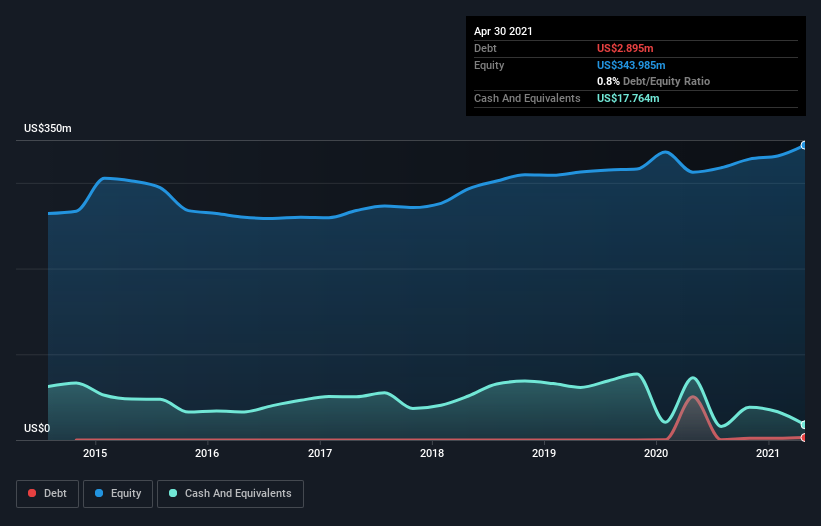We Think Raven Industries (NASDAQ:RAVN) Can Stay On Top Of Its Debt
David Iben put it well when he said, 'Volatility is not a risk we care about. What we care about is avoiding the permanent loss of capital.' So it might be obvious that you need to consider debt, when you think about how risky any given stock is, because too much debt can sink a company. We note that Raven Industries, Inc. (NASDAQ:RAVN) does have debt on its balance sheet. But the real question is whether this debt is making the company risky.
When Is Debt A Problem?
Debt and other liabilities become risky for a business when it cannot easily fulfill those obligations, either with free cash flow or by raising capital at an attractive price. Ultimately, if the company can't fulfill its legal obligations to repay debt, shareholders could walk away with nothing. However, a more frequent (but still costly) occurrence is where a company must issue shares at bargain-basement prices, permanently diluting shareholders, just to shore up its balance sheet. Having said that, the most common situation is where a company manages its debt reasonably well - and to its own advantage. When we examine debt levels, we first consider both cash and debt levels, together.
View our latest analysis for Raven Industries
What Is Raven Industries's Net Debt?
You can click the graphic below for the historical numbers, but it shows that Raven Industries had US$2.90m of debt in April 2021, down from US$50.4m, one year before. However, it does have US$17.8m in cash offsetting this, leading to net cash of US$14.9m.
How Strong Is Raven Industries' Balance Sheet?
Zooming in on the latest balance sheet data, we can see that Raven Industries had liabilities of US$60.1m due within 12 months and liabilities of US$26.7m due beyond that. Offsetting this, it had US$17.8m in cash and US$68.9m in receivables that were due within 12 months. So its total liabilities are just about perfectly matched by its shorter-term, liquid assets.
Having regard to Raven Industries' size, it seems that its liquid assets are well balanced with its total liabilities. So it's very unlikely that the US$2.07b company is short on cash, but still worth keeping an eye on the balance sheet. Despite its noteworthy liabilities, Raven Industries boasts net cash, so it's fair to say it does not have a heavy debt load!
On the other hand, Raven Industries saw its EBIT drop by 5.5% in the last twelve months. That sort of decline, if sustained, will obviously make debt harder to handle. When analysing debt levels, the balance sheet is the obvious place to start. But ultimately the future profitability of the business will decide if Raven Industries can strengthen its balance sheet over time. So if you're focused on the future you can check out this free report showing analyst profit forecasts.
Finally, a company can only pay off debt with cold hard cash, not accounting profits. While Raven Industries has net cash on its balance sheet, it's still worth taking a look at its ability to convert earnings before interest and tax (EBIT) to free cash flow, to help us understand how quickly it is building (or eroding) that cash balance. Happily for any shareholders, Raven Industries actually produced more free cash flow than EBIT over the last three years. That sort of strong cash conversion gets us as excited as the crowd when the beat drops at a Daft Punk concert.
Summing up
While it is always sensible to look at a company's total liabilities, it is very reassuring that Raven Industries has US$14.9m in net cash. And it impressed us with free cash flow of US$19m, being 106% of its EBIT. So is Raven Industries's debt a risk? It doesn't seem so to us. The balance sheet is clearly the area to focus on when you are analysing debt. But ultimately, every company can contain risks that exist outside of the balance sheet. To that end, you should be aware of the 1 warning sign we've spotted with Raven Industries .
When all is said and done, sometimes its easier to focus on companies that don't even need debt. Readers can access a list of growth stocks with zero net debt 100% free, right now.
This article by Simply Wall St is general in nature. It does not constitute a recommendation to buy or sell any stock, and does not take account of your objectives, or your financial situation. We aim to bring you long-term focused analysis driven by fundamental data. Note that our analysis may not factor in the latest price-sensitive company announcements or qualitative material. Simply Wall St has no position in any stocks mentioned.
Have feedback on this article? Concerned about the content? Get in touch with us directly. Alternatively, email editorial-team (at) simplywallst.com.

 Yahoo Finance
Yahoo Finance 
